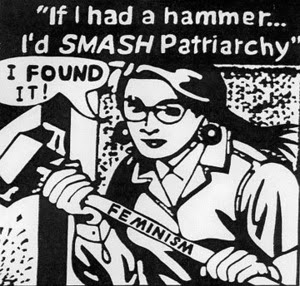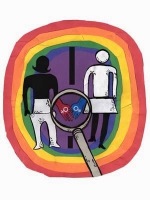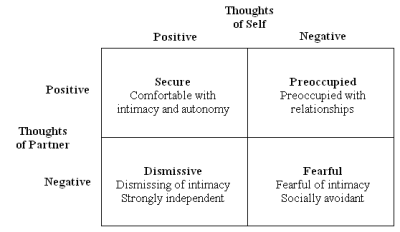I had the opportunity to attend the American Association of Marriage and Family Therapists (AAMFT) annual conference- it was pretty convenient given it is in Portland this year 🙂
I was most excited about today, because my events included:
A workshop on Sexuality in Family Therapy
A discussion on LGBTQ youth
And a workshop on Plural Families
Tomorrow includes a workshop on treating children with trauma and how to treat couples where abuse has occurred.
So many things to say!
1. Sexuality in Family Therapy: The facilitators of the workshop conducted research on therapist attitudes toward client perceived sexual problems (presenting as a sex addict) based on whether the client was monogamous or in an open marriage and a man or a woman. Participants in the study in which they read one vignette; the four possible vignettes only differed in the gender of the client and the relationship style. Women in open marriages were rated most negatively and pathologized the most, meaning that therapists were most likely to refer a woman in an open marriage for treatment and to label her sexual behaviors as problematic. Next worst were men in open marriages. Next were men in monogamous marriages. Women in monogamous marriages were rated least negatively (least likely to have their behaviors labeled as problematic). My takeaway: our society still very much pathologizes and demonizes female sexuality. Promiscuous women=bad news. Promiscuous men? Bad, but expected. Monogamous women? Virtuous.
The presenters also discussed the issue of including children and teenagers as part of family therapy, even when issues of sexuality needs to be discussed- of course, in age-appropriate, developmentally-appropriate ways. Also, therapists must be aware of their own reservations or issues around sexuality so that they can best serve their clients by using explicit language, calm demeanor, and engage in frank conversation about sexuality and sex. (I think I will be okay regarding that!)
2. LGBTQ & Youth: We talked a lot about queer therapists self-disclosing their queer identity to queer clients. Is it appropriate? When? What are the effects of self-disclosure? Also: why aren’t queer issues a bigger part of the AAMFT conference? Why aren’t queer issues given a workshop space or a keynote address??
3. Plural Families: I was so jazzed for this one, because I thought for sure it would be addressing polyamorous families. Wrong! The presenters intentionally stayed away from polyamory, and instead focused on polygamous and plural marriages. It was still super interesting, and when I asked the presenters why they chose to focus on polygamy and didn’t include polyamory, their reasoning was that they didn’t want to just lump all of these alternative relationship structures together and ultimately do a disservice to both. That made sense to me. There was also some good discussion that I participated in about ensuring that therapists do not collude with polynormativity and remembering that poly relationships come in all shapes, sizes, and flavors. I also talked to one of the presenters after the workshop, and she works with people in poly relationships, people in the BDSM community, and trans* folks. So awesome!!! She told me there are only a handful of loud and proud marriage and family therapists serving those communities. I’m excited to join the ranks! They handed out some fabulous resources. The following one is my favorite; I can’t believe I hadn’t run across it before!! Cory Davis made a monogamy privilege questionnaire, akin to Peggy McIntosh’s Unpacking the Invisible Knapsack targeted toward discovering white privilege. It’s fabulous: Monogamous Privilege Checklist.
In fact, I am just going to copy and paste it here as well:
For the purposes of this list, I will refer to one’s position on the diagram of monogamy vs. various types of non-monogamy (polyamory, open marriage, swinging, religious polygyny, etc.) as simply “relationship orientation”.
Note that for the purposes of this list, “relationship orientation” does NOT refer to one’s sexual orientation re: the Kinsey scale (heterosexual, homosexual, bisexual, pansexual, etc.). Monogamous individuals who are LGBTQ and/or in interracial and/or intergenerational romantic relationships may well be exempt from some (though not all) of these privileges, especially those marked with an asterisk at the end.
Monogamous Privilege Checklist:
1) I can legally marry whomever I wish, with all the legal, medical, and financial benefits of marriage universally recognized for me and my family no matter where I live.*
2) I am not accused of being abused, warped, immoral, unethical, or psychologically confused because of my relationship orientation.
3) No one ever questions the validity of my love because of my relationship orientation.
4) It is not assumed based on my relationship orientation that I or any of my former or current partners has been misled, coerced, manipulated, or used in any way.
5) No one argues that my relationship orientation is impractical, unstable, incompatible with commitment, or otherwise effectively impossible to realize. No one argues that my relationship orientation works better in theory than in practice.
6) It is not assumed that my life must be overly-complicated because of my relationship orientation.
7) No one tries to convert me to their relationship orientation.
8 It is not assumed that I will switch relationship orientations as soon as I find the “right” person.
9) It is not generally understood that I am unfit to raise children because of my relationship orientation.
10) I can feel certain that my government will not suddenly remove my children to a foster home based on my relationship orientation.
11) As a responsible and loving parent, I won’t lose my children in a custody battle because of my relationship orientation.
12) As a responsible and loving adult, I can adopt children without lying about my relationship orientation.
13) I can be certain that my children won’t be harassed because of my relationship orientation.
14) My children are given texts and information at school that validates my family structure – two parents with kids, two sets of grandparents, etc.
15) It is not assumed based on my relationship orientation that my children are/were raised in an unstable environment.
16) No one assumes or speculates based on my relationship orientation that my children experience or ever will experience emotional, psychological, social, or behavioral problems.
17) I do not have to explain my relationship orientation to strangers whenever it comes up.
18) People don’t ask why I made my choice of relationship orientation.
19) People don’t ask why I made my choice to be public about my relationship orientation.
20) I don’t have to defend my relationship orientation.
21) I am not identified, categorized or grouped by my relationship orientation.
22) I am never asked to speak for everyone who shares my relationship orientation.
23) My individual behavior is not thought to reflect on all persons who identify with my relationship orientation.
24) If a romantic relationship of mine ends, no one blames my relationship orientation.
25) I can be sure that all of my roommates, classmates, and coworkers will be comfortable with my relationship orientation.
26) When I talk about my monogamy (such as in a joke or talking about my relationships), I am never accused of pushing my relationship orientation onto others.
27) I do not have to fear revealing my relationship orientation to friends or family. It’s assumed.
28) I do not have to fear that if my family, friends, or professional community find out about my relationship orientation there will be economic, emotional, physical, or psychological consequences for me or for others.
29) I can run for political office without expecting that my relationship orientation will disqualify me.
30) I can depart from most meetings, classes, and conversations without feeling fearful, excluded, isolated, attacked, outnumbered, unheard, held at a distance, stereotyped or feared because of my relationship orientation.
31) I can date whomever I wish, regardless of whether or not they previously identified with my relationship orientation, without fear that my new partner will be shunned by their friends and family due to their choice to embark upon a relationship with someone of my relationship orientation.
32) I am guaranteed to find people of my relationship orientation represented in my workplace.
33) I can be sure that my classes/courses/training will require curricular materials that testify to the existence of people with my relationship orientation.
34) I can easily find a religious community that will not exclude me based on my relationship orientation.
35) I am guaranteed to find sex education literature for people with my relationship orientation.
36) I can count on finding a therapist or doctor who will recognize my relationship orientation as valid, should I seek their services.
37) I can be sure that if I need legal or medical help my relationship orientation will not work against me.
38) Public hand-holding with my love is seen as acceptable and endearing. I can walk in public with my partner and not have people stare or do a double-take.*
39) I can choose not to think politically about my relationship orientation.
40) I can remain oblivious to the language and culture of other relationship orientations (i.e. polyamory, swinging, etc.) without paying any penalty for such obliviousness.
41) Even if I am oblivious about other relationship orientations, my culture affords me the privilege of judging those orientations and being an authoritative source of relationship advice because I am monogamous. This is especially true if I am a therapist, researcher, media darling, or other authority figure.
42) In everyday conversation, the language my friends and I use generally assumes my relationship orientation. For example, “family” meaning monogamous relationships with children.
43) Nobody calls me monogamous with malice.
44) I am not asked to think about why I am monogamous.
45) Society encourages me to marry and celebrates my commitment.*
46) My relationship orientation is commonly represented in music, television, movies, books, magazines, greeting cards, and postcards.
47) Major, mainstream social networking websites such as Facebook allow me to set my relationship status according to my relationship orientation.
48) I can go to relationship and dating events (i.e. singles events, relationship skills workshops) secure in the knowledge that my relationship orientation will be the standard and will be catered to.
49) I never need to change pronouns when describing the events of my life in order to protect my job, my family, or my friendships.*
50) If I’m a teenager, I can enjoy dating, first loves, and all the social approval of learning to love appropriately within my relationship orientation.*
51) If I’m called to work with children or to serve God (in most denominations), I don’t have to lie about my relationship orientation in order to keep my job.
52) I can count on my community of friends, acquaintances, strangers, and various institutions to celebrate my love and my family, mourn my losses, and support my relationships.*
53) It is not assumed merely because of my relationship orientation that I am experienced in sex (or that I even have it at all!).
54) It is not assumed that I am inclined toward my relationship orientation purely for sexual reasons.
55) It is not assumed based on my relationship orientation that I am more likely than average to have STIs.
56) It is not assumed based on my relationship orientation that I am unaware of the risks posed by my sexual behavior.
57) I am not assumed based on my relationship orientation to be sexually indiscriminate.
58) I do not have to deal with the language and culture of my relationship orientation being co-opted, redefined, and demonized by an unfriendly majority which controls the media.
59) No one ever calls my relationship orientation “creepy” or “disturbing”.
60) I can befriend people without them and/or their romantic partners assuming that I am trying to convert them to my relationship orientation.
61) No one takes issue with their children being around me based on my relationship orientation.
62) I can be fairly certain that anyone who is in a committed, romantic relationship with me will also be invited to most parties, weddings, and other social events to which I am invited.*
63) No one makes assumptions about my political views or religious beliefs based on my relationship orientation.
64) No one refers to my relationship orientation by the wrong term or label, either intentionally or inadvertently.
65) I do not have to coin or invent terms to describe my relationship orientation and familial connections to others, because the language describing my relationship orientation already exists and is known throughout the culture.
66) No one ever ridicules or makes jokes about the terminology that people with my relationship orientation commonly use to describe their relationship structures and familial connections.









